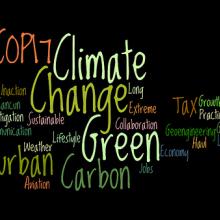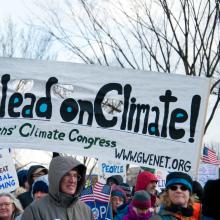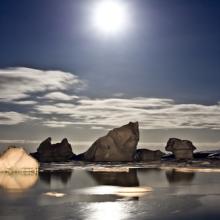carbon
In 2014, Shepherdstown Presbyterian Church in West Virginia installed an array of 60 solar panels with a scrappy financial model, hoping to lead by example and inspire other communities in Appalachia to transition to solar energy as well.
June 2 is going to be a big deal.
Why? Because EPA Administrator Gina McCarthy is about to unveil our biggest climate change policy ever.
It didn’t go through Congress because Congress continues to fail us on our most urgent threat to the planet — even though the majority of Americans in every state agree that climate change is happening and we are the main cause and despite the recent news from the National Climate Assessment that climate change is happening now, and the effects are visible in every single state.
Instead, the Obama Administration is acting on climate change through the Environmental Protection Agency (EPA). The President’s Climate Action Plan has a number of policies within it, including energy efficiency for congregations, and this latest rule will limit carbon pollution from our existing power plants.
BAN KI MOON has summoned the world's leaders to New York in September to talk about the climate—and in the process he's also summoned all of us who care about the planet's future. We'll be there in record numbers, for the largest demonstrations about global warming yet—and there will be, I think, an unavoidable edge of anger. Because calling these guys "leaders," at least on this issue, is by now a joke.
Take President Barack Obama, for instance. He ran for office promising, in almost biblical terms, that during his administration "the rise of the oceans would begin to slow." Installed in office, he summoned environmentalists to the White House where his staff informed them that he wouldn't be talking about climate change: "Green jobs" tested better in focus groups.
And President Obama was true to his word. He hardly ever talked about climate change: He summoned no political muscle to back attempts at a climate bill in the Senate, and he watched as the Copenhagen climate talks collapsed, the biggest foreign policy failure in many years.
When Obama run for president in 2012, he made it through the whole campaign—during the hottest year in U.S. history—without even mentioning global warming. And while he delayed half of the Keystone pipeline, he "expedited" approval of the southern section, boasting that his administration had built enough new pipelines to wrap around the equator. He has modest decreases in carbon emissions to herald—and massive increases in oil and gas drilling. On his watch the United States will pass Russia and Saudi Arabia as a hydrocarbon source.
WONDERFULLY, WE FIND ourselves very much alive in “a large and beautiful house,” as Cicero called it in his day. We know it was built not only for “the sake of mice and weasels,” or “immortal gods,” but for the entire array of life on Earth.
As we behold the remarkably habitable abode we call Earth, we are left to wonder: What is this grand house in which we live, move, and have our being? What makes it such a habitable abode?
The answer is written elegantly before our eyes in creation itself. And when we join this with reading God’s word, we find the foundation of the answer: “The [geophysical] earth (ge) is the Lord’s and its fullness, the [biosphere] (oikoumene) and everything that lives in it,” as it says in the Septuagint translation of Psalm 24:1.
We discover as grateful dwellers in this most habitable abode that we also are its housekeepers. If we mess it up, it will teach us something about proper housekeeping. And from scripture we learn that we are its Earth-keepers, commissioned, as the Anglican Communion puts it, “to strive to safeguard the integrity of creation and sustain and renew the life of the earth.”
In the beautiful architecture of Earth, we find the foundations of life in the geophysical earth as well as keystone species in its biosphere. In the architecture of our houses and churches, we find structures of our own crafting, such as foundations, cornerstones, columns, arches, domes, and keystones.
Significantly, one of these architectural features appears in the name “Keystone XL,” the proposed tar sands oil pipeline. Architecturally, a keystone locks together two legs of an arch. If completed, Keystone XL would do much the same.
PHYSICS IS IMPLACABLE—it won’t bend even to politics.
Which is why it comes as bad news to see the charts on U.S. production of fossil fuels. During the Obama years, even as the president has been touting his administration’s success in reducing our domestic carbon emissions, it turns out that we’ve been drilling, mining, and fracking for more oil, coal, and gas than ever before. In fact, we’ve passed Saudi Arabia in oil production and are about to pass Russia in oil and gas output combined; meanwhile our coal exports have reached new highs. We’ve become the world’s biggest fossil fuel producer.
Which means that, precisely in the years when it’s become clear how much damage climate change is doing—the years of Midwest drought, of Hurricane Sandy—the United States has been bucking physics. We’re going in exactly the wrong direction.
The White House might make two arguments in response. One, it’s not their fault: The oil boom in places like North Dakota is all private enterprise. But in fact Obama’s done much to grease the skids for this boom: He’s opened up big offshore tracts for drilling, and even let the oil companies into the Arctic. His Interior Department has held auctions for vast piles of Powder River Basin coal.
Editor’s Note: This post contains two of many testimonies given at an Environmental Protection Agency (EPA) listening session at EPA headquarters in Washington, D.C. The EPA held sessions in 11 regional offices across the country to allow the public to comment on the agency’s plans to begin regulating carbon dioxide emissions — one of the heat-trapping pollutants that contributes to climate change — from existing coal and natural gas-fired power plants. The public was invited to share up to three minutes of spoken testimony to an EPA panel for the agency’s consideration. We also have multiple other testimonies in parts two and three.
I’ll be traveling to New York tomorrow with a number of Christian colleagues. We’re having a rally — a Climate Action Prayer Rally! And you can join us!
I’m not sure about you, but I’m incredibly disappointed that our nation’s leaders – from all sectors, all parties, and all levels – continually neglect to take leadership on our climate and energy crisis.
There are many reasons that climate change should be a top election issue, but here are just a handful of the most important ones.
COAL, NATURAL gas, petroleum. Thoughtlessly we call these substances “fuels”—fuels to burn for creating pleasant climates inside homes and offices; fuels to power appliances and engines. For years, like nearly everyone, I never thought beyond our mere use of these things. I neglected to consider their role in the Earth’s wider economy.
This all changed when my family moved to a Wisconsin peatland in 1972. Since then, conducting research there with my graduate students has produced four decades of discovery.
For thousands of years, wetland plants and algae in a bay of glacial Lake Waubesa took carbon dioxide from the atmosphere. They transformed it by photosynthesis into the carbon structure of life, eventually adding their remains, page upon page, to the accumulating peat. Eventually, this peat filled the bay for an area more than a mile long, reaching a depth of 95 feet at the present lake edge. When first I walked here, I saw the vibrant surface of plants and wetland creatures; now, in my mind’s eye, I also see the deep-layered remains of creatures below.
Also standing and walking here (much more gracefully than I) are sandhill cranes. These stately creatures, as conservationist Aldo Leopold observed, “stand, as it were, upon the sodden pages of their own history.” Elsewhere, the sodden pages of peat deposits have been cut over the ages to be dried for fuel. The early Romans saw this practiced by conquered peoples of northern and western Europe. Peat was also used as fuel in Ireland, Scotland, and northern Europe after forests were cleared for agriculture. And peat is the precursor of coal, transforming under geologic pressure into brown coal, bitumen, bituminous coal, and anthracite.
U.S. Top Destination for Christian, Buddhist Immigrants, Study Saysl; Abdo Husameddine, Syria Deputy Oil Minister, Defects; Washington’s New Antiwar Movement; The Pentagon's (Preliminary, Shaky, And Hypothetical) War Plan For Syria; Arab Spring Fails To Allay Women's Anxieties; Progressives Petition Hoyer Against Safety Net Cuts; Carbon Fast 2012: Christians Give Up Carbon For Lent

COP 17 image via Wylio http://bit.ly/vjX59V
After two weeks of extensive talking, and running hours beyond schedule, a deal to cut global carbon emissions finally has been reached. As the climate conference in Durban, South Africa came to a close last weekend, a treaty known as the Durban Platform emerged, requiring all countries to begin curbing carbon emissions by 2020.
The deal binds all countries — rich and poor — to “hold the increase in global average temperature below 2C or 1.5C above pre-industrial levels,” according to the Framework Convention on Climate Change. Further, plans for enhanced action must be solidified by 2015, with the contracts bearing legal force.
Michael Jacobs, a member of the of the Grantham Research Institute on Climate Change and the Environment in London, told the BBC that " by forcing countries for the first time to admit that their current policies are inadequate and must be strengthened by 2015, it has snatched 2C from the jaws of impossibility. At the same time it has re-established the principle that climate change should be tackled through international law, not national, voluntarism.”
But the treaty has its drawbacks.
This Lent, Christians are invited to “Fast from Carbon.” The Regeneration Project’s Interfaith Power and Light carbon fast is a reminder that although global warming threatens







